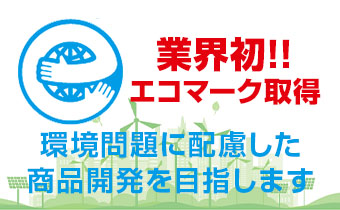- Home
- Know / Enjoy
- High pressure technology
- What is "high pressure processing"?

What is "high pressure processing"?
Mankind has been using heat (fire) for cooking and processing food for 300 million years.However, heat consumes a large amount of energy, and has problems such as changes in the taste, color, and aroma of food, destruction of nutrients, and production of harmful substances.
So independent as well as heat"Pressure" which is a state-changing factor of matterBy using (factors that convert the states of solids, liquids, gases, etc.), food processing that is completely different from the case of using heat becomes possible. If you compare "heat" to your right hand and "pressure" to your left hand, it can be said that in the 21st century, human beings can finally process food with both hands.

"Fire" (hihen) and ",,,," (rekka) are used for the kanji used for cooking food, such as "boil, bake, steam, cook, smoke, heat ..." I am.
By using pressure, it acts on food sterilization, denaturation, texture, digestibility, etc., and enables food processing that is safe, secure, healthy, aging, and environmentally friendly.
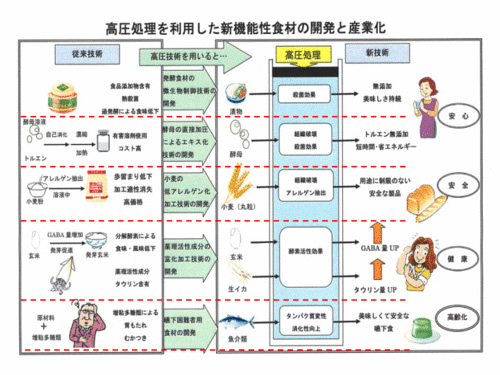
Many problems that could not be treated by heat alone may be solved by introducing high-pressure treatment.
Water under high pressure
Water is commonplace, but it is a mysterious liquid that has become the recipient of the birth of life.
Most ingredients and foods contain water.The water content of raw rice is 15.5%, that of rice cake is 43%, that of rice is 60%, and that of watermelon is about 90%.
Knowing water is important for food processing, as there are no foods that are incompatible with life phenomena.
So what are the effects of pressure on water conditions?
Generally, water turns into ice at 0 ° C and boils at 100 ° C.
However, this is just a phenomenon under "1 atm".
For example, in high mountains where the air pressure is low, water boils at temperatures below 100 ° C.
On the contrary, what happens when pressure is applied to water?
The figure below is a phase diagram of water with temperature on the vertical axis and pressure on the horizontal axis.
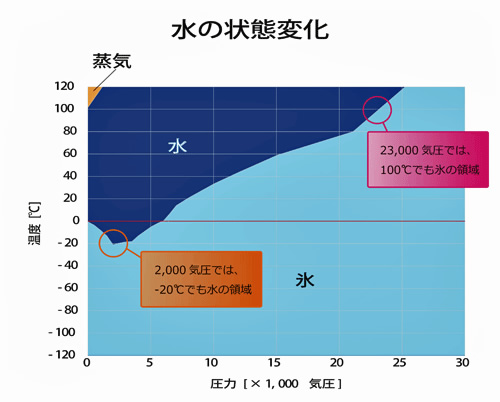
It shows that ice (individual) at -20 ° C exists as water (liquid) at 2000 atm, and even vapor (gas) at 100 ° C becomes ice (individual) at 23,000 atm.Pressure, like heat, is an independent state-changing factor.
Comparison of high-pressure treated Eggs and heat-treated Eggs
High-pressure treatment is a technology that uses high pressure (isotropic hydrostatic pressure) of 1,000 atm or more for food processing.
What happens when Eggs, which are familiar ingredients, are processed under high pressure?
When a high pressure is applied to a raw Egg, the same equal reaction force is applied from the inside to the outside of the Egg, so the Egg will not crack.
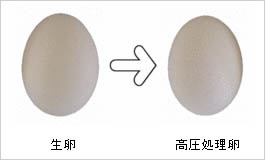
Let's take a look at the contents of the Egg.
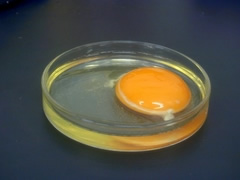 (a) Raw Egg |
|
| High pressure processing | Heat treatment |
|---|---|
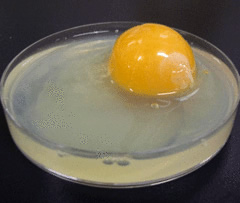 (b) 4000 atm x 10 minutes (normal temperature) |
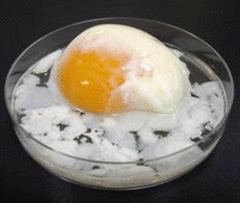 (c) 63 ℃ x 10 minutes |
| Comparing a liquid raw Egg (a) with a pressure of 4000 atm (b) and an Egg heated with hot water at 63 ° C, the yolk of the pressure Egg (b) is solidified and the white remains liquid.On the other hand, in the heated Egg (c), the yolk remains liquid and the white meat is solidified, indicating that the protein of the Egg shows different denaturation with heat and pressure. | |
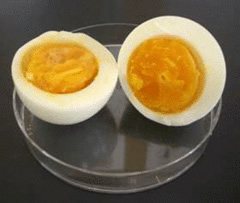 (d) 7000 atm x 10 minutes (normal temperature) |
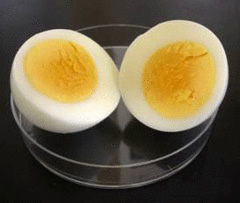 (e) 100 ℃ x 10 minutes |
| Comparing the Egg (d) with a high pressure of 7000 atm and the Egg (e) heated at 100 ° C, the pressure Egg (d) hardens to white and looks like a boiled Egg.Heated Eggs (e) are common boiled Eggs | |
- ・ Color change The white part is indistinguishable, but the yolk of the high-pressure Egg is bright and not as white as a boiled Egg.
- ・ Changes in aroma and taste Boiled Eggs have a unique sulfur odor, but high-pressure Eggs do not, and retain the scent of raw Eggs.
- ・ Changes in texture When chewed, the texture and tongue are different, and the yolk of a boiled Egg feels crumbled, while the high-pressure Egg is smooth and chewy, and does not crumble even if you try to crush it with your fingers.
- ・ Changes in taste The taste of high-pressure Eggs remains raw.
- ・ Digestibility According to an artificial digestion test using protease, it is reported that the digestibility is better than that of boiled Eggs.
- ・ Vitamin loss No vitamin loss has been reported by chemical analysis.
Egg comparisons suggest the possibility of using pressure as a new food processing alternative to heating that does not compromise the flavor or nutritional value of the food.
- TV commercial
- High pressure technology
- What is "high pressure processing"?
- About the unit of pressure
- History of high pressure research
- High-pressure treatment of food
- High-pressure equipment and research content
- Products using high pressure
- Industrialization of high pressure technology
- Contribution to QOL
- Possibility of high pressure technology
- Recipes
- Pettan Club
- Encyclopedia of rice cakes and rice




